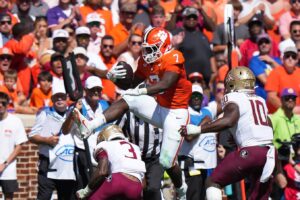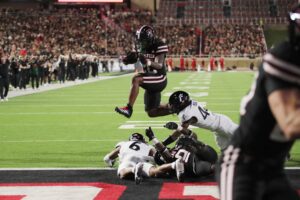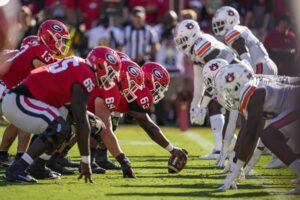Making the Case for WVU to the ACC
The only constant in this world is change. College football fans face a series of sweeping changes that will alter the game they love forever. In some cases, it might be good. In others, it may not. Last Word on Sports started examining that change several years ago when the transfer portal first arose. It wrote a series of articles on impending NIL rules that have since taken hold. WVU fans have stared down their share of change over the last decade. Now, as their conference faces an impending collapse, WVU has some options. For those options to become reality, however, someone has to convince the right people to move forward with yet another change. Thus, I present my opening argument while making the case for WVU to the ACC.
WVU’s Brand Value Offers the ACC Growth Potential
The “Flying WV” in the Old Gold and Blue has an interesting and unique backstory. Writing for WVU Magazine, Jake Stump did that story enough justice that I will simply just link to it here.
The Birth of WVU’s Modern Era
I start with Stump’s recounting for good reason. The logo synonymous with WVU first entered the stream of commerce at the beginning of the 1980 football season. In that same season, the Mountaineers played their first game at Milan Puskar Stadium (then, simply, Mountaineer Field). And that season also ushered in the Don Nehlen era.
Thus, at a brand new (sold out) Mountaineer Field, John Denver performed “Country Roads” before the Mountaineers, led by Oliver Luck and Robert Alexander, helmed by a new Head Coach, and sporting new colors and a new logo, opened their new season, and era, with a 41-27 over Cincinnati.
Don Nehlen, to most, is rightfully credited with putting the Mountaineers “on the map.” The current brand of WVU football began with its 1980 season.
WVU’s Performance in the Modern Era
Once Nehlen arrived, so did the Mountaineers as we know them today. Nehlen himself was responsible for 13 winning seasons in 21 years. During his tenure, WVU won 149, or 61.5%, of their games. His teams were responsible for several seasons of the “special” variety, including two undefeated regular seasons. Major Harris remains a college football legend to this day for his performance in the first of those two seasons. Nehlen’s Mountaineers repeated the performance five years later.
Though these seasons, because they both ended with bowl losses, represent a falling short to some WVU fans, they should–and do–represent national relevance to others. Nobody, including me, will pretend that these seasons make West Virginia a “blue blood” program worthy of top 10 consideration.
But here is what they do represent. The flagship university of an oft-maligned State of just over a million people played a smash-mouth brand of football and won some pretty big games along the way. These are things they shouldn’t have been able to accomplish in the first place.
Enter the White/Slaton Era
A few years after Rich Rodriguez took the baton from Nehlen, the Mountaineers found their way into the national spotlight again, posting three straight 11-win seasons. Pat White and Steve Slaton found their way into various All-American and Heisman watch lists. Like Major Harris before him, Pat White set the bar for dual-threat quarterbacks for a number of years. Once again, those overlooked young men playing football proved that West Virginia mattered, too. And while they, too, fell short (the most heartbreaking moment for WVU fans to relive), they still made a huge dent in national perception of the program.
From the 2001 season to the 2010 season, the “Flying WV” earned 88 wins, capturing three BCS Bowl wins along the way. Only ten Power Five teams accumulated more wins than WVU during that time. Only one (Virginia Tech) resides in the ACC. On the all-time wins list, West Virginia ranks 15th. This era cemented West Virginia’s place as a Top-25 program historically.
Making the Case: The “Flying WV” Brand
Based on this success, WVU has earned a reputation of on-field performance that, by and large, exceeds expectations. Any West Virginian will tell you: we enjoy the role of underdog. We thrive there. Our teams earned that reputation through blue-collar work on the field matching the spirit of the State. Since Nehlen came to Morgantown in 1980, the Mountaineers have won 63% of their games. Because we don’t have any professional teams with which to compete for in-state, the vast majority of the State’s attention trains on its flagship football team for half of each year.
This has earned West Virginia a top-ten ranking on multiple brand value lists over the last several years, including number seven on this one. The passion of its fanbase also propels WVU to a seemingly yearly finish as a top-20 school in terms of licensing revenue. Its fans buy more stuff than two-thirds of the current Power Five conferences. In other words, far more people pay attention to West Virginia’s brand than one might suspect.
WVU’s Viewership Offers the ACC More Than You’d Think
Because of that brand, and because of the exciting football West Virginia has played over the years, the team has a built-in following.
To compare West Virginia’s TV numbers to the rest of the ACC requires context. With the ACC Network, the number of conference games on networks reporting ratings has decreased. They have far fewer games on “satellite” networks like ESPN2, ESPNU, FS1, FS2, etc. Instead, their most relevant games earn first-tier broadcasting slots, while the rest of their games are jettisoned to the ACC Network.
Those ratings are not reported. Indeed, I reviewed TV viewership at Sports Media Watch. The number of ACC games with viewership numbers dwindled significantly in 2019 and 2020. Therefore, I looked at 2018 because this is the last year that most ACC teams had a full slate of games with reported viewership numbers.
This next bit may be incredibly difficult for some to believe, but you can verify yourself here. In 2018, West Virginia’s average number of TV viewers per game eclipsed the average for every single ACC team except Clemson. Indeed, West Virginia averaged 2.47 million viewers per game in 2018 (good for third in the Big 12). That was more than Miami (1.67 million), Florida State (2.07 million), Pitt (1.98 million), and Virginia Tech (2.03 million).
When West Virginia is playing relevant football, its brand turns on TV sets. This remains the case despite the fact that West Virginia doesn’t fit with the Big 12. Storylines here simply aren’t as interesting as they were in years past. The brand could easily have eroded with the move. But it has stood strong.
We will see a preview of how much WVU improves ACC viewership in Week 3 when Virginia Tech visits Morgantown. As a preview, though, I looked at the 2017 numbers. West Virginia’s game against Virginia Tech drew 4.74 million viewers to the ABC night game slot. Virginia Tech played two other games in that slot, one against Clemson (4.69 million viewers) and the other against Miami (3.01 million viewers). Indeed, that game was the most-watched game in which Virginia Tech played that season, even eclipsing the Hokies’ bowl game.
In a World of Change, Offer a Return to the Familiar
I cannot offer thoughts making the case for WVU to the ACC without touching on the history WVU shares with ACC teams. West Virginia found itself in the Big 12 as a result of the last round of realignment. Louisville tried to disrupt that move, but the Big 12 preferred the Flying WV brand. As a result, Louisville landed in the ACC. In hindsight, perhaps West Virginia regrets that move. At the time, though, it was the only Power Five move they had available to them.
Despite being the odd man out, West Virginia still offers substantial brand value, and that value only increases with a move to the ACC. Here’s why. In a world filled with rapid-fire change that threatens to leave behind many of those fans (who still watch games . . . for now) who grew up watching more regionally-focused college football. One way the powers-that-be can combat that change and offer “stability” to long-time fans is to renew dead rivalries.
West Virginia has played 104 games against Pitt, 71 games against Syracuse, 52 games against Virginia Tech, 33 games against Boston College, 23 games against Virginia, and 20 games against Miami. Not each of those games represents a rivalry, per se, but they do offer compelling storylines and familiarity that can swim against the current.
This increases WVU’s brand, makes it more recognizable, and offers it as an adversary to fan bases that are far more familiar with the history of the matchups. It also increases the number of “relevant” (thus nationally-televised games in which the ACC would play). The Backyard Brawl would draw eyes. The Battle for the Black Diamond Trophy would draw eyes. Even games featuring West Virginia and Miami or Florida State would draw eyes. In a world of change, the ACC has a chance to offer fans a return to the familiar. Doing so would be mutually beneficial.
[pickup_prop id=”9425″]
Are We Really Going to Discuss Academics?
The biggest criticism of WVU has been its academic profile. In part, it is fair. But West Virginia has a very specific academic mission as the flagship university in the State of West Virginia. As a result, the average GPA and test scores for its admitted students are lower than in more prestigious universities. This is true. But WVU’s mission is to admit as many in-state students as possible. The in-state options are limited. There is not an East Carolina to North Carolina’s UNC. Speaking of UNC, a wide-reaching academic scandal certainly shoots the foot off of an argument that the ACC takes academics as seriously as it claims.
Ultimately, the reason we are even discussing the fit is that the SEC made a purely monetary decision to capitalize on the financial windfall offered by two prestigious athletic programs. Any moves to follow would be driven by the revenue of sports programs, not academic standing.
Not that WVU doesn’t offer that, though. It is one of just 120 Carnegie R1 research institutions. Where it lacks in perceived “bench depth” academically, it does a lot to make up for at the upper echelons. It has more Rhodes Scholars than over half of the ACC Universities. Its medical school has made internationally acclaimed advancements in numerous fields, including Alzheimer’s research. In short, should this even prove to be a relevant consideration, we can find plenty of evidence to overcome any perceived shortcomings on the whole.
Making the Case for WVU to the ACC: In Closing
In short, it is hard to imagine a better fit for WVU than the ACC. It is also hard to imagine a better program to pair with any other school the ACC may look to add than WVU. It offers a valuable brand with plenty of fans and alumni to add to the conference’s revenue. The old adage that the whole is worth more than the sum of its parts also matters here. Because the value of the ACC brand, and the brands of several schools, will also increase by restoring traditional rivalries at a time when fans are hesitant to embrace constant change. Now, all that’s left is to make it happen.






